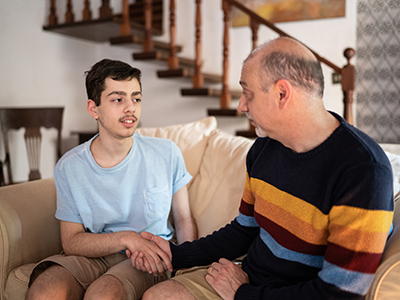“What am I even looking at right now?” If you’re like most people, this is the thought that goes through your head when you sit down to try to understand the latest research on autism. When I first started graduate school, the numbers, figures and statistics in research articles were overwhelming, so it was difficult, and sometimes impossible, to make sense of the information.
Most importantly, it was difficult to understand the problems with the study (because no study is perfect), so it was hard to understand when the study was relevant for a specific person. It can be really hard to find the information you want to think about when you are not sure what you are looking at.
Also, while most of us enjoy the latest blog post that summarizes research, many of us also want to go right to the primary source and see for ourselves what the latest research about autism has to say.
The goal of this article is to help you break down the best ways to find research, evaluate it and extract relevant information.
Where to find articles
Psychologists have a lot of different ways to find articles on the latest research. Typically, we search on research databases which are search engines specifically for scientific research. Some are broader (i.e., PubMed) and some are specific to the field of psychology (i.e., APA PsycArticles).
The problem with using these databases as a non-psychologist is that you have to pay for most of the articles and it can be expensive. In order to get around this requirement (a paywall), you’re going to want to look for what’s called an “Open Access Journal.” Although there can be great articles in these journals, they also tend to accept lower quality pieces than the journals that are behind a paywall. You’re going to want to pay special attention to the “red flags” section below so you can evaluate the quality of the article you’re looking at.
Some well-known, reputable journals with a focus on neurodevelopmental conditions include:
Whenever you’re selecting a journal or article to browse, you’ll want to look for something indicating that it is “peer-reviewed” meaning that other scientists have read it and approved it.
I also highly recommend Google Scholar which is a database run by Google that includes both open-access and paywall-limited articles. You’ll have to sort through more results, but you’ll get the most results for your efforts.
Which brings us to: How do I search a database? Answer: with ‘keywords.’ Keywords are a combination of two or three words that are related to the information you’re looking for. For example, if I want to know more about the latest in neurodiversity research I might type in the words: “Autism AND Neurodiversity AND Joy.” To make sure you’re getting the most up-to-date results, you can select a recent publication year (for example, “Since 2021”).
How to judge the quality of an article (red flags)
Of course, even when we pull them from reputable sources, not all research is going to be of the same quality. Red flags are used to warn us about problems. For research, red flags refer to problems to think about regarding the accuracy of the findings. (Bonus: These “red flags” apply to articles you read in any source, so keep them in mind when you are scrolling on your tablet or phone.) The first thing I look for to determine how much stock to put in the findings is the number of participants and the diversity of the participants.
Typically studies with smaller groups of people run a higher risk of getting results that don’t apply to most other people, and a higher risk of results just being a “fluke” or coincidence. The same goes for when the study is only white people, only males, only middle-class, etc.
Red flags to keep an eye out for are:
- When there are very few participants in a study
- When the sample is limited to one particular group of people (unless you’re looking for info specifically on that group)
- When an article makes a big sweeping claim
Scientists know that it takes a lot of data and a lot of doing the same study over and over again (this is called “replication of findings”) to be reasonably sure about something. Be VERY wary of broad, sweeping claims such as phrases like “totally eliminate difficult behaviors,” “cure” anything autism related, “we are sure that X causes Y” etc.
Real science is slow and cautious, and if something sounds too good to be true — IT PROBABLY IS. If you notice these statements, put the article down and move on. What you’re looking for are phrases like, “given the findings, we think it’s likely that X impacts/is related to Y, but more research should be done on ABC to see if it supports these findings.” This shows that the person is aware of the complexity of the issue and respectful of the cautious nature of the scientific process.
Final thoughts
Science and knowledge are for everyone and part of our mission here at CASD is to make that knowledge as accessible as possible to the families that we serve. Although we hope it’s helpful, this is obviously a very brief overview of a complicated topic! Next month, we will review the different sections of articles and suggest strategies to make it easier to get the most information from what you read.
For those who want a more in-depth look, the Organization for Autism Research (OAR) has a free guide written for families and self-advocates who want to dive into the research, and it is much more detailed.
Also, if you have worked with a professional — such as the clinician who evaluated someone in your family or current therapist — ask for a consultation to discuss if a therapeutic approach you’ve learned about is right for you or your family.
Happy reading!!
 https://riseandshine.childrensnational.org/wp-content/uploads/2025/06/boy-with-concussion-Feature.jpg
300
400
Danielle Robbins
https://riseandshine.childrensnational.org/wp-content/uploads/2017/11/childrens_riseandshine_logo.jpg
Danielle Robbins2025-06-11 11:47:322025-06-11 11:47:32Concussions in Autistic children
https://riseandshine.childrensnational.org/wp-content/uploads/2025/06/boy-with-concussion-Feature.jpg
300
400
Danielle Robbins
https://riseandshine.childrensnational.org/wp-content/uploads/2017/11/childrens_riseandshine_logo.jpg
Danielle Robbins2025-06-11 11:47:322025-06-11 11:47:32Concussions in Autistic children





















Leave a Comment
Want to join the discussion?Feel free to contribute!